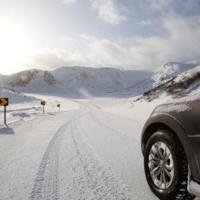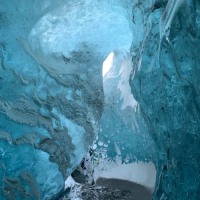The island of fire and ice not only offers an unforgettable holiday in summer but also in winter. There are numerous activities and highlights where everyone gets their money's worth. Although December has the shortest days in Iceland, with only four to five hours of daylight, many streets and houses are decorated with colorful lights during the Christmas holidays. Moreover, winter is a time to travel without the hustle and bustle of summer and you are rewarded with northern lights and icy waterfalls.
Weather
 The weather in Iceland can change rapidly and can be unpredictable at times. The average temperatures in the winter months in Iceland are -5 to 5°C, depending on where you are. In the southern regions, such as Reykjavik, it is usually somewhat warmer than in the northern areas, although one should not forget the wind, which blows strongly all year round and can lower the temperature. For this reason, it is recommended to pack enough warm clothing for the holiday, which is also rainproof in the best case. The two-piece look is particularly practical, as it allows you to put on or take off another piece of clothing without feeling uncomfortable.
The weather in Iceland can change rapidly and can be unpredictable at times. The average temperatures in the winter months in Iceland are -5 to 5°C, depending on where you are. In the southern regions, such as Reykjavik, it is usually somewhat warmer than in the northern areas, although one should not forget the wind, which blows strongly all year round and can lower the temperature. For this reason, it is recommended to pack enough warm clothing for the holiday, which is also rainproof in the best case. The two-piece look is particularly practical, as it allows you to put on or take off another piece of clothing without feeling uncomfortable.
Driving in winter
 In contrast to the highlands, which are no longer usable from the beginning of September, the ring road is passable all year round and is well developed. Even small feeder roads, e.g. to Dettifoss, are usually closed in winter. When choosing a car, you should therefore opt for a car with four-wheel drive, as otherwise many roads are impassable. Due to the low daylight, we recommend planning shorter daily trips in winter and packing enough snacks for the tour.
In contrast to the highlands, which are no longer usable from the beginning of September, the ring road is passable all year round and is well developed. Even small feeder roads, e.g. to Dettifoss, are usually closed in winter. When choosing a car, you should therefore opt for a car with four-wheel drive, as otherwise many roads are impassable. Due to the low daylight, we recommend planning shorter daily trips in winter and packing enough snacks for the tour.
We recommend that you obtain information on driving in Iceland from the website www.drive.is before the trip. During the trip, you should pay attention to up-to-date weather information, current road conditions (www.road.is or tel. +354 1777) and travel warnings (www.safetravel.is and https://safetravel.is/driving). It is also a good idea to look at the route carefully before each trip to know where to go. If you have any questions about driving conditions, road conditions, or weather assessments, the Icelanders are happy to help. After all, they are used to the harsh winters and are well-placed to assess whether a trip can be made without hesitation.
Northern lights in Iceland
 Northern Lights, also called Aurora Borealis, are caused by particles ejected into the atmosphere by the sun during solar explosions. These particles hit the atmosphere in the Earth's magnetic field and release energy that leads to the discoloration of the sky. Due to their charge, the particles are particularly attracted to the poles of the northern and southern hemispheres, as the Earth's magnetic field has openings here. The color of the northern lights depends on several factors, such as the height of the magnetic field or the type of atoms.
Northern Lights, also called Aurora Borealis, are caused by particles ejected into the atmosphere by the sun during solar explosions. These particles hit the atmosphere in the Earth's magnetic field and release energy that leads to the discoloration of the sky. Due to their charge, the particles are particularly attracted to the poles of the northern and southern hemispheres, as the Earth's magnetic field has openings here. The color of the northern lights depends on several factors, such as the height of the magnetic field or the type of atoms.
In general, northern lights are more likely to be seen in the darker months of the year, from September to April. To find out if there is a chance of seeing the Northern Lights you need to consider several factors: The time of sunrise, sunset, and moonrise, and the current cloud cover. For help, you can look at the Icelandic Meteorological Office website. The office collects all relevant data and provides a northern light forecast in scale form from 0 to 9, where 0 means calm and 9 means strong. If the night is particularly dark, a forecast of 3 is sufficient to see the magical lights. We have summarized more detailed information about the Northern Lights and how to photograph them here.
The question: "Where can you see the Northern Lights in Iceland?" often comes up when planning a trip. In general, it is possible to see the magical lights all over Iceland if conditions are favorable, but some places are easier to reach and more appealing than others. The most famous places are probably Thingvellir National Park in the south, Asbyrgi Gorge in the north, and the mountain Kirkjufell in the west. There are also boat tours that specialize in observing the Northern Lights from the shore.
Iceland's thermal springs
 Iceland's many thermal springs are open to visitors all year round. Since geothermal energy has been used in Iceland, the tradition of public bathing is deeply rooted in the local culture. For this reason, there are also hundreds of public baths throughout Iceland, with 16 of them in the greater Reykjavik area alone. Icelanders use the pools not only for health reasons but also for social reasons: They can relax there and socialize with friends at the same time.
Iceland's many thermal springs are open to visitors all year round. Since geothermal energy has been used in Iceland, the tradition of public bathing is deeply rooted in the local culture. For this reason, there are also hundreds of public baths throughout Iceland, with 16 of them in the greater Reykjavik area alone. Icelanders use the pools not only for health reasons but also for social reasons: They can relax there and socialize with friends at the same time.
Probably the best-known thermal spring is the Blue Lagoon,which is located about 5km north of the town of Grindavik and has been in operation since the late 1990s. Another spring is the Myvatn Natural Bath, which is located in the north of Iceland on the Diamond Circle route near the ring road. Here you can even admire fantastic northern lights in winter under good conditions. Another hot spring in the north is Geosea Thermal Bath in Husavik, where you can enjoy both the hot water and the view of the open sea.
Glacier walking
 Unlike ice cave tours, glacier walks are also possible in summer. The most popular places for glacier hiking are all on the south coast of Iceland. These include:
Unlike ice cave tours, glacier walks are also possible in summer. The most popular places for glacier hiking are all on the south coast of Iceland. These include:
- Solheimajokull glacier tongue is part of the Mýrdalsjökull glacier and is one of the most popular options for glacier hiking due to its proximity to Reykjavik. On the way to the glacier, you also pass some of the most beautiful sights on the south coast (Skogafoss waterfall, Vik beach, etc.).
- The Svinafellsjokull glacier is located in Skaftafell National Park and is a glacier tongue of the huge Vatnajokull glacier.
Fascinating Ice caves

In the winter months, when temperatures drop and remain permanently low, ice caves form in the Vatnajökull glacier and other glaciers, where meltwater flows under or through the glacier and causes the existing ice to thaw. This creates the unique hollow space of the cave. In summer, the spaces become unstable or even melt and collapse, which is why you can only visit them in winter. The thawing and refreezing in winter means that the caves are unique and special every year and you always have a breathtaking experience. And even if a cave is no longer accessible the next winter due to instability, the local guides look forward to finding new ice caves in the new season. A visit to an ice cave can also be combined with a glacier hike.
A wide range of excursions can be booked directly with us - just contact us! For more ideas, take a look at our other winter trips.
